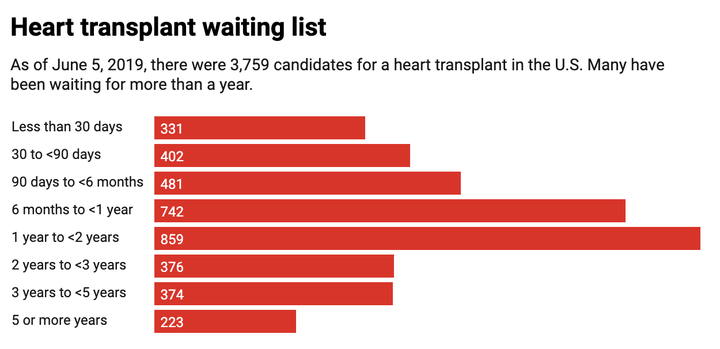By Leora Yarboro and Elizabeth D. Krebs
Heart disease is the top cause of death in the U.S. For some people with end-stage heart disease, a heart transplant can save their life.
Unfortunately, there are currently more patients on the heart transplant list than there are suitable donors. As a result, half of the patients on the heart transplant list wait for over a year. Some will die without ever getting a heart.

As doctors who work with patients who desperately need heart transplants, we want to be sure that we are using all of the organs that we can.
One thing that is important in heart transplantation is finding the right size organ for the recipient. A heart that is too small may not support the patient. A heart that is too big may not fit in the patient’s chest. Weight has been used by many transplant centers as a way to ensure a good size match between the donor and recipient.
Today, 40% of Americans can be classified as obese. Almost 8% fall into the category of severe obesity, which is a body mass index greater than 40. These numbers have increased significantly since 2003 and are still going up.
Many heart transplant centers require that heart transplant recipients keep their BMI at 35 or less. As the donor pool becomes increasingly overweight, our concern is that severely obese donors may get overlooked, because of the mismatch between the donor and recipient weights.
Oversized hearts
In our donor heart study, published as an abstract in April, we looked at two questions.
First, what percentage of donor hearts come from super obese donors, with a BMI over 40? Second, what are the outcomes for patients who receive a heart from a donor who is super obese?
To answer our questions, we used the United Network for Organ Sharing database. We looked at all the heart transplants that were done in the U.S. between 2003 and 2017.
Of over 26,000 heart transplants, 3.5% were from donors who had a BMI over 40. Mirroring societal trends, the prevalence of super obese donors increased over time, from 2.2% in 2003 to 5.3% in 2017.
Obese donors were older and were more likely to have other medical problems, including diabetes and hypertension. In two-thirds of the transplants, the donors were considered oversized, at 130% the weight or more of the recipient.
Ordinarily, heart transplant doctors might think that more preexisting medical problems and older donor hearts, as seen in the super obese donor group, would result in more complications for the recipient.
However, in looking at over 10 years of data using these organs, our data suggests that this is not the case. Complications — such as postoperative dialysis, acute rejection or postoperative stroke — were the same for patients who had a super obese heart transplant donor as they were for patients who did not have a super obese heart donor.
People who received hearts from super obese donors also had similar long-term outcomes, including survival, as recipients of hearts from non-super obese donors.
Accepting suitable hearts
As doctors who work with patients that need transplants, we feel that it is important to improve awareness about how to become an organ donor.
It is also important to look critically at the organs that are being donated and make sure that they are being used to their fullest potential. Every year, patients die while waiting for a heart transplant.
This study shows that, for donors with a BMI over 40, it’s safe to use carefully selected hearts — screened for other important criteria examined in all donor hearts, like a history of coronary disease.
This data can potentially serve to expand the number of suitable donors for those patients in need.
Leora Yarboro is an associate professor of thoracic and cardiovascular surgery and Elizabeth D. Krebs is a resident physician in general surgery at the University of Virginia Medical Center.
This article is republished from The Conversation, a nonprofit independent news site dedicated to unlocking ideas from academia for the public, under a Creative Commons license. Read more about organ donation here.
REAL LIFE. REAL NEWS. REAL VOICES.
Help us tell more of the stories that matter from voices that too often remain unheard.
Credit: Source link